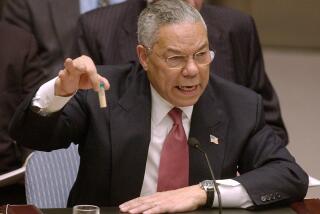Pentagon Called Bush Message to Hussein Too Cautious : Policy: Senior officials reportedly felt that President’s 1990 wording was too soft to avert the Iraqi invasion of Kuwait.
- Share via
WASHINGTON — Senior Pentagon officials tried unsuccessfully to prevent President Bush from sending a message to Iraqi leader Saddam Hussein a few days before the invasion of Kuwait because they feared it was too weak to halt Iraqi aggression, former Administration officials said Sunday.
The attempt to block the President’s message came as the Pentagon and the CIA were increasingly convinced that Iraqi troops were preparing an invasion of Kuwait, according to former officials and sources.
However, the State Department and White House blocked the Pentagon attempt, and Bush sent a cautious communique to Hussein on July 28, 1990, just five days before the invasion. Bush asked Hussein to avoid military action, but he did not name Kuwait and couched the request in terms of a continued desire for friendship.
“By the 24th (of July), when the Iraqi troops were moving, there was no question about how serious this was,” Henry S. Rowen, then the assistant secretary of defense for international affairs, said in an interview. “The particular instruction was unnecessarily weak in our view.”
The disclosure of the Pentagon objection to Bush’s message, first reported in the New York Times, fuels the debate over whether the Bush Administration was stern enough in dealing with Hussein in the days leading up to the invasion.
White House Press Secretary Marlin Fitzwater attributed the flap over the message to Hussein to a heated presidential campaign in which Bush appears to be narrowing the gap that Democratic nominee Bill Clinton enjoys.
He said that a lot of people are trying “to embarrass the President by saying: ‘I told him to do this and he didn’t want to do it. I advised him to be tough and be weak or be strong.’ It’s crazy.”
Bush was first urged to send a strong warning to Hussein in an Administration options paper in May, 1990. The Iraqi leader was threatening to use his army to settle a dispute with Kuwait over oil prices and the border between the two countries.
The White House rejected the proposal, preferring the assurances of its Arab allies that Hussein would not resort to force and that he should be dealt with diplomatically.
By late July, the Defense Department was concerned as 35,000 Iraqi troops moved to the border with Kuwait. Sources said that reconnaissance satellites spotted the Iraqis laying secure communications lines near the border, evidence that they were serious about an invasion.
“Those of us at Defense were deeply concerned about the Iraqi troop buildup and we thought they were going to go,” said Marvin C. Feuerwerger, a Middle East strategist at the Defense Department at the time and now an analyst at the Washington Institute for Near East Policy.
On July 25, Hussein had met with U.S. Ambassador April Glaspie and discussed his dispute with Kuwait and U.S.-Iraq relations.
A personal response to Hussein from Bush was drafted at the White House and State Department. The draft was shown to Pentagon officials on July 27 and Rowen said that they feared its cautious tone did not indicate a U.S. willingness to defend Kuwait with military forces.
“We voiced objections to the State Department and thought we had a hold on it,” said Rowen, now a professor at Stanford University and senior fellow at the conservative Hoover Institution. “It needed to be much tougher.”
By late July, CIA officials were alarmed by Iraq’s buildup on the Kuwaiti border. Infrared photography from a spy satellite showed Iraqi troops hauling ammunition, fuel and water to forces along the northern border with Kuwait, according to “Eclipse,” a new book on the CIA by Mark Perry.
On the morning of July 28, according to the book, CIA Director William H. Webster led a contingent of agency officials to the White House to brief Bush. The satellite photographs were presented to Bush, along with the CIA’s assessment that Hussein might attack Kuwait.
But later that day, the three-paragraph message was sent to Hussein. Five days later, on Aug. 2, Iraq invaded Kuwait.
A senior Bush Administration official involved in drafting the message to Hussein said that Saudi Arabia, Egypt and Kuwait were urging Bush not to respond harshly. He pointed out that Hussein had told Glaspie that he intended to negotiate a resolution to his differences with Kuwait.
“The sense at that point was not to roil the waters just when they were getting calm,” said the official.
Congressional Democrats have accused Bush of being too soft on Iraq in a number of areas, including continuing U.S. credits for loans in the face of strong evidence of Iraqi abuse. The Administration has defended extending the aid in part by citing a May 21, 1990, report by the Agriculture Department which found little evidence of serious Iraqi abuses in the program.
An internal Justice Department document obtained by The Times provides the harshest criticism yet of the report. The May 21, 1990, memo by a federal prosecutor in Atlanta warned that the report was inaccurate and could constitute misleading Congress if it were released.
Prosecutor Gale McKenzie, who was leading the investigation into the abuses in connection with a massive bank fraud, urged the department to try to block the report’s release. But it was released anyway.
A senior Agriculture Department official defended the report, saying that it reflected the best evidence available and that no more Iraqi loans were guaranteed even though the program remained technically open until the day after the invasion of Kuwait.
More to Read
Get the L.A. Times Politics newsletter
Deeply reported insights into legislation, politics and policy from Sacramento, Washington and beyond. In your inbox twice per week.
You may occasionally receive promotional content from the Los Angeles Times.










